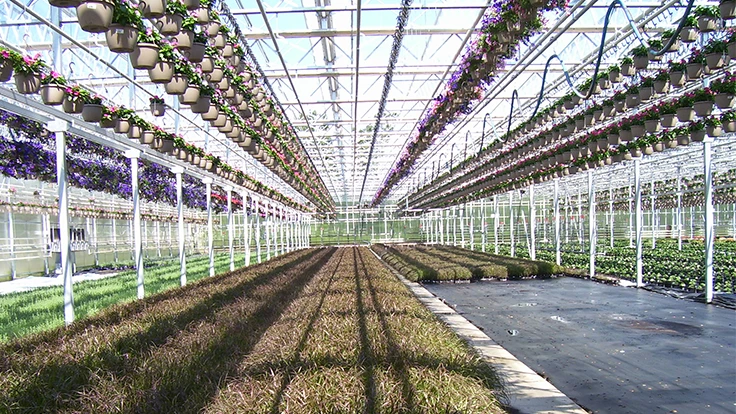
Photo: John W. Bartok Jr.

Over the past few years, the gutter height on new greenhouses has been increasing. Greenhouses built during the energy crisis of the 1970s usually had an 8-foot height to conserve on energy. Today, for various reasons, 12 feet is the minimum and 16 feet is the standard with some houses being built with gutters more than 20 feet for some purposes. What are the advantages of going taller? The following comments may help you decide.
Greater air volume means slower temperature change. Increasing the height from 12 feet to 16 feet increases the volume by over 20 percent. The larger volume takes a longer time to heat up or cool down.
Natural ventilation is more effective. Natural ventilation systems operate on the principle that heat is removed by a pressure difference created by wind and temperature gradients. The ridge of a taller house receives more wind currents creating a better draft. Buoyancy is the other component. Cool air near the floor becomes lighter as it is heated and rises toward the roof. The greater distance between the floor and the roof vent, the greater the temperature difference.
Light reaching the plants is more uniform. It may not be obvious, but the farther the greenhouse frame and fixtures are above the floor, the lighter the shadows become. This can result in greater uniformity and more light reaching into the lower canopy.
Room for additional energy/shade screens. Screens are valuable for both saving energy in the winter and excluding heat in the summer. A single screen can save up to 40 percent of the winter heat. Adding a second screen can reduce heat loss another 10 to 15 percent. At least 12 inches is needed to install a second screen. Usually these are located at the top and bottom cord of the energy truss for tight closure.
Room for tall crops. Crops such as tomatoes, cucumbers and cannabis need vertical room for growth. Usually a 16-foot minimum gutter height is required with 20 feet being better for long season crops.

Multiple layers of hanging baskets mean more production in the same footprint. With the use of multiple hangers or a motorized conveyor system, two or three levels of baskets can be grown along with a crop on the floor. Essentially the same size heating and cooling systems will serve the greenhouse whether the gutter is at 12 feet or 16 feet.
There are some negatives that can offset the advantages.
The taller greenhouse is more expensive to build. The wind load on a tall house is increased due to the greater wall surface area. Larger support members and more bracing may be needed for the extra load. Also, additional wall glazing is needed. This amounts to 1 to 1.5 percent of the total surface area for each foot of additional height.
Heating costs are increased. As heat loss is directly related to the surface area of the greenhouse, the extra wall area adds some to the heat needed. Larger heaters may be needed.
Greater ventilation fan capacity is needed. For greenhouse gutter heights less than 12 feet, most engineers calculate fan capacity at 8 cfm/square foot of floor area. Recommendations for heights above that are better designed with fan capacity at 10 cfm/square foot.
Increased horizontal air flow (HAF) fan capacity is also needed. As there is more air to move, it requires more power to move it. A good recommendation for houses with greater than a 12-foot gutter height would be to design with about 2.5 cfm of fan capacity for each square foot of floor area.
Labor costs may increase. If taller crops will be grown, employees may have to use elevating platform equipment to tend and harvest them.
When planning a new gutter-connected greenhouse, review the above factors based on the crops to be grown and the level of environment control desired.

Explore the April 2018 Issue
Check out more from this issue and find your next story to read.
Latest from Greenhouse Management
- Anthura acquires Bromelia assets from Corn. Bak in Netherlands
- Top 10 stories for National Poinsettia Day
- Langendoen Mechanical hosts open house to showcase new greenhouse build
- Conor Foy joins EHR's national sales team
- Pantone announces its 2026 Color of the Year
- Syngenta granted federal registration for Trefinti nematicide/fungicide in ornamental market
- A legacy of influence
- HILA 2025 video highlights: John Gaydos of Proven Winners





